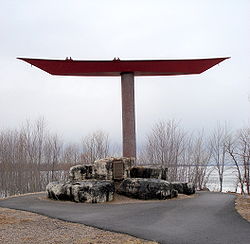
Pointer boat
Encyclopedia

Eastern White Pine
Pinus strobus, commonly known as the eastern white pine, is a large pine native to eastern North America, occurring from Newfoundland west to Minnesota and southeastern Manitoba, and south along the Appalachian Mountains to the northern edge of Georgia.It is occasionally known as simply white pine,...
timber
Timber
Timber may refer to:* Timber, a term common in the United Kingdom and Australia for wood materials * Timber, Oregon, an unincorporated community in the U.S...
down the wider sections of the Ottawa River
Ottawa River
The Ottawa River is a river in the Canadian provinces of Ontario and Quebec. For most of its length, it now defines the border between these two provinces.-Geography:...
.
Pointer boats were unique. Not only were they as sturdy as the East Coast fishing dory, but they could carry eight men while floating in only five inches of water. Empty, a pointer with a dead weight of half a ton or more drew only one and a half inches of water. Even though the boats ranged in length from 22-50 feet, to turn one end-for-end needed only one pull on an oar. Because the boat was double-ended (identical bow and stern), workers could focus on the task at hand rather than on which way the boat was facing.
John Cockburn began his boat building business in Ottawa
Ottawa
Ottawa is the capital of Canada, the second largest city in the Province of Ontario, and the fourth largest city in the country. The city is located on the south bank of the Ottawa River in the eastern portion of Southern Ontario...
, Ontario
Ontario
Ontario is a province of Canada, located in east-central Canada. It is Canada's most populous province and second largest in total area. It is home to the nation's most populous city, Toronto, and the nation's capital, Ottawa....
, Canada
Canada
Canada is a North American country consisting of ten provinces and three territories. Located in the northern part of the continent, it extends from the Atlantic Ocean in the east to the Pacific Ocean in the west, and northward into the Arctic Ocean...
after being commissioned by John R. Booth to build a sturdy boat for logging. In 1859 he moved his business to Pembroke, Ontario
Pembroke, Ontario
Pembroke is a city in the province of Ontario, Canada, at the confluence of the Muskrat River and the Ottawa River in the Ottawa Valley...
. Up to then, the finished boats were being shipped the 145 miles to Pembroke by horse and sleigh. The Cockburns fashioned their boats to last at least ten seasons in normal use. However, due to rough water and rocks some did not last a single season. In peak years, the Cockburn family produced two hundred pointers.
For more than one hundred years the Cockburns used the same materials and made relatively few changes to the design. The boats were planked in local red or white pine. White Cedar from Allumette Island in the upper Ottawa River had bent roots suitable for making into ribs. Red Pine or White Spruce was fashioned into oars while the paddles were made from Yellow Birch
Yellow Birch
Betula alleghaniensis , is a species of birch native to eastern North America, from Newfoundland to Nova Scotia, New Brunswick, southern Quebec and Ontario, and the southeast corner of Manitoba in Canada, west to Minnesota, and south in the Appalachian Mountains to northern Georgia.It is a...
, or White Oak
White Oak
White Oak may refer to:* Quercus alba, a species commonly known as the White Oak* any of various trees from the botanical section Quercus within the list of Quercus species* a 1921 silent western written/produced by and starring William S...
. Beside Cockburn’s shop was a building in which wood was air-dried for twelve months before use.
Construction began with a plywood template and laying out the bottom side planks. Then, the stern and bow posts were temporarily attached. The center width of the boat was then blocked in. Binding ropes and stays were applied and tightened into the final shape of the boat. After this, each tongue and groove siding plank would carefully be selected at equal length and nailed in. The process of slackening, tightening the rope and adding siding planks was repeated until the boat was of proper size. Working from the center of the boat to the stern and bow, the cross frames and supporting ribs were installed. Finally, the V-bottom shape was precisely crafted to achieve a shallow draft. The end product was then treated with a preservative made from boiled (linseed?) oil and jewelers rouge, which gave them a red Venetian appearance.
John Cockburn’s business spanned three generations to his son Albert, and then, to grandson Jack. Jack Cockburn continued to produce Pointer Boats in 1969 before he died in 1972. Although the boats were designed for logging they have been used in other industries such as mining, power and construction industries for getting to remote terrain. In recognition to the Cockburn family and the historical impact the Pointer Boat had on the logging industry, a 32 foot steel replica of the Pointer boat was built in Pembroke. Today this replica is known as one of the “Large Canadian Roadside Attractions”

